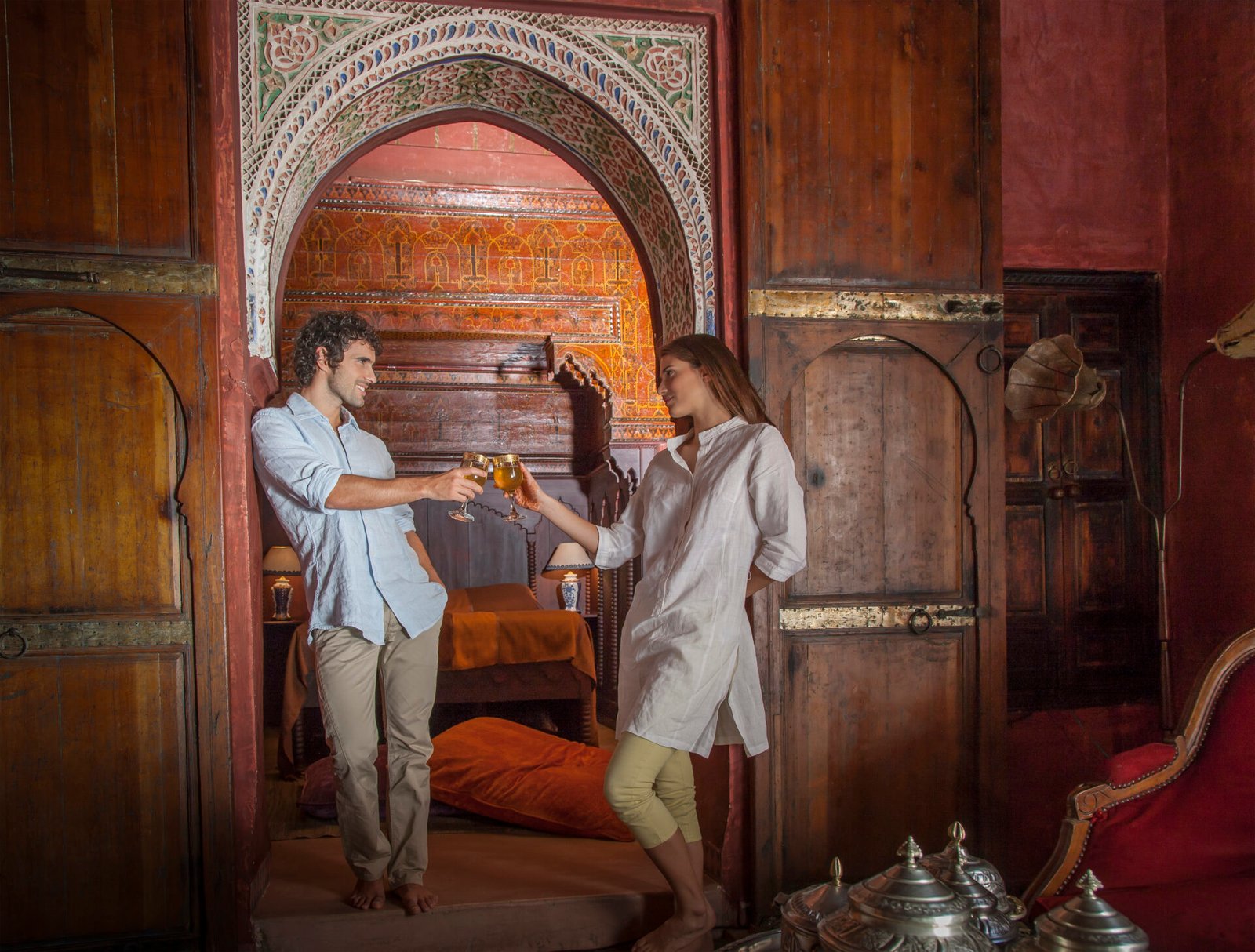Moroccan Traditions: Rituals, Festivals, and Ancestral Customs
Morocco is a land of contrasts and colors, but above all, it is a country rich in ancestral traditions. From north to south, Berber, Arab, Andalusian, and African cultures blend together to create a vibrant cultural mosaic. Each celebration, ritual, and festival is a window into the soul of Morocco, revealing the values of community, spirituality, and celebration. Whether it’s through music, dance, or traditional dress, Moroccans preserve a deep connection to their roots.
🎉 Traditional Festivals and Moussems
The Rose Festival in El-Kelaâ M’Gouna 🌹
Every May, the small town of El-Kelaâ M’Gouna in the Valley of Roses comes alive with festivities celebrating the rose harvest. Women in traditional attire throw rose petals, parades fill the streets with music and color, and a “Rose Queen” is crowned. It’s a joyous, floral celebration of spring and community.
🔗 Read more about the Rose Festival here
Gnaoua World Music Festival in Essaouira 🎶
A spiritual and cultural highlight, the Gnaoua Festival fuses traditional Gnaoua music with jazz, reggae, blues, and world sounds. Held every summer in the port city of Essaouira, this festival celebrates the musical and mystical legacy of the Gnaoua people — descendants of Sub-Saharan Africans.
Mawazine Festival in Rabat 🌍
Mawazine Rhythms of the World is one of the largest music festivals in Africa and the world. For over a week, Morocco’s capital transforms into a huge open-air stage, bringing together global superstars and Moroccan artists. A true celebration of diversity and cultural openness.
🔗 Visit Mawazine Official Website
The Marriage Moussem of Imilchil 💍
In the High Atlas Mountains, the Moussem of Imilchil is a gathering of nomadic Aït Haddidou tribes for a traditional mass wedding ceremony. According to legend, this ritual dates back to a tragic love story and today symbolizes freedom of choice in marriage within a deeply rooted tribal framework.
🔗 Learn more about this unique Berber tradition
Fantasia (Tbourida): Tribal Equestrian Art 🐎
Fantasia is a spectacular traditional equestrian performance. Riders gallop in synchronized formations and fire old muskets in unison. This centuries-old display reflects values of courage, honor, and martial discipline passed down through generations.
🔗 UNESCO Intangible Cultural Heritage – Tbourida
🕌 Religious Rituals and Spiritual Practices
Islam deeply permeates daily life in Morocco, with numerous rituals marking the year.
- Ramadan: A sacred month of fasting, prayer, and sharing. The atmosphere changes completely: streets come alive at dusk, and families gather to break the fast with traditional dishes.
- Eid al-Adha (Festival of Sacrifice): The most important festival in the Muslim calendar, marked by the sacrifice of a sheep in memory of Abraham’s gesture—a strong family tradition based on generosity and sharing.
- Sufi Rituals: Sufi brotherhoods, notably the Gnaoua, practice trance ceremonies accompanied by music and mystical chants, aiming to purify the soul and connect with the divine.
👰 Traditional Weddings and Henna Ceremonies
Moroccan weddings are among the most spectacular social events, often lasting several days and following a highly codified sequence.
- Hammam: Before the wedding, the bride undergoes a ritual purification in a steam bath, surrounded by her close ones.
- Henna Night: A festive evening where the bride receives henna designs symbolizing fertility, luck, and protection—a highly anticipated moment filled with songs and dances.
- Traditional Attire: The bride wears several caftans, often richly embroidered, and is accompanied by a negafa (wedding assistant). The groom also dons traditional attire, sometimes in white or cream.
🍵 The Mint Tea Ritual: Hospitality and Art of Living
Offering tea is one of the most emblematic gestures of Moroccan hospitality. It is consumed at any time of the day, whether among friends, family, or with guests.
- Preparation: Green tea is infused with fresh mint and plenty of sugar, then poured from a height to create a characteristic foam.
- Symbol of Welcome: Served slowly and ceremoniously, tea unites people in a moment of sharing and conviviality.
🧕 Traditional Clothing and Handicrafts
Moroccan clothing reflects a rich cultural diversity depending on regions and occasions.
- Djellaba and Caftan: Worn by men and women, these are loose, elegant garments, often adorned with embroidery or trimmings, used in daily life as well as during celebrations.
- Artisanal Crafts: Moroccan culture is also found in architecture and everyday objects: zellige mosaics, tadelakt plaster, pottery, wrought iron, carpet weaving—each item tells a story, handcrafted with care.
🛍️ The Souks: Between Tradition and Bargaining
Souks are traditional markets where exchanges go far beyond a simple act of purchase.
- The Art of Haggling: Bargaining is a well-established tradition, practiced in good humor and reflecting mutual respect between seller and buyer.
- Typical Products: Colorful spices, leather babouches, copper lamps, Berber jewelry, handwoven rugs, essential oils, ceramics—each item offers a glimpse into local craftsmanship.
🧭 Why Discover Moroccan Traditions?
Traveling to Morocco is more than just visiting grand landscapes; it’s about experiencing profound human connections, meeting passionate artisans, sharing tea under a nomadic tent, or witnessing a fantasia in a remote village.
Understanding Moroccan traditions opens a window into a lifestyle imbued with spirituality, elegance, and generosity. Whether in the heart of medinas, in the Berber villages of the Atlas, or amidst the dunes of the Sahara, local customs will accompany you at every step of your journey.

